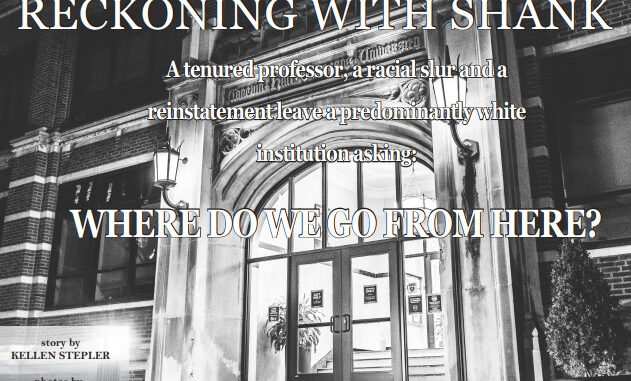
Editor’s Note: Due to the length of this piece, this article has been split up into three parts on our website. This is part one of Reckoning with Shank: A Tenured Professor, a racial slur and a reinstatement leave a predominantly white institution asking, Where do we go from here?
Kellen Stepler | The Duquesne Duke
Images by Griffin Sendek | Multimedia Editor
April 8, 2021
“What’s the one word about race that we’re not allowed to use? I’ll give you a hint, it starts with N.”
Duquesne professor Gary Shank asked his Educational Psychology class that question, in a Sept. 9 Zoom lecture.
Shank then used the N-word — and gave students permission to use it, too — in a two minute video clip widely circulated on social media. In the clip, he explained how the word was used in a “pedagogical sense,” and gave examples of how the word was used when he was younger.
“It was really tense; we knew it was wrong,” said sophomore Erin Wrisley, who was in the class. “Everyone turned their camera off. No one knew what to do.”
Despite him apologizing to the class, Duquesne officials fired Shank — leading him to file a grievance against the university.
Duquesne’s grievance committee recommended in January that Shank be reinstated, and a month later, university President Ken Gormley would allow Shank to return to teach in the fall under certain requirements.
“I was shocked,” said classmate Kaytlin Black. “He was on paid leave, then fired, but now he can come back? I don’t understand what happened.”
The reaction to Shank’s controversial return was mixed. But it also posed a question to the Duquesne community: Where do we go from here?
“Intention doesn’t negate impact”
Once the decision was made in February, some students wrote to faculty to ask how the decision was made, and what they could do to make the university reconsider.
“People should have been surprised when they found out Shank could come back,” said Zeke Daure, a sophomore in Shank’s class. “I was shocked. You don’t expect things like that. I thought it was over and done with in September.”
Following the announcement Feb. 5, Daure sent an email to students in a social justice course, along with Shank’s Educational Psychology course, to gather experiences students have had with Shank.
He was under the impression that he would have the opportunity to speak with Gormley and university officials to talk about the incident and decision.
But he said he never got that chance. “With a tenured professor, it’s hard for things to change,” he said. “There’s not much you can do.”
Daure said that the university can’t expect people to take Shank’s class again — and that Shank’s actions occurring over Zoom were the “best way” for it to happen.
“In a classroom, it might have never gotten out. He could have denied saying it,” he said. “I’m glad it happened over Zoom.”
In the fall 2020 semester, Black students in Duquesne’s School of Education accounted for 6.07% of the student body.
“I went to a predominantly white high school. People know what’s right and wrong in this world. There’s differences, but it’s how we accept those differences,” Daure said. “We all have different experiences through race, but it’s all about being accepting,” he said.
Wrisley also tried to e-mail professors to see what she could do, because she “was caught off guard by [him coming back.]”
“I was not happy. I’m white, so I don’t feel the sting as much as my peers of color did, but it still made me angry,” she said. “I told them I was not pleased and asked what I could do to rectify the incident and make the university reconsider. The professor told me she was also troubled — but with tenure, there’s nothing I could do.”
It made sophomore education major Katie Rhodes feel “defeated.”
“There are so many students that were affected negatively by his careless acts, and the thought of him returning makes me worry for the students who feel uncomfortable with him being a teacher, including myself,” Rhodes said.
Anthony Kane, the director of diversity and inclusion at Duquesne’s Center for Excellence in Diversity and Student Inclusion, said he believes that the incident impacted the perception students of diverse populations have regarding faculty allyship and the university.
“The incident opened dialogues about the use of hate speech and racial slurs on campus,” Kane said. “Furthermore, this incident showed us firsthand as a community that we are not immune to the acts of injustice and incivility that we see across our nation.”
Following the lecture, Shank apologized to his class in an email with the subject line, “My most sincere apology.” He said that he used the racial epithet as a part of his pedagogy.
However, Jessica Mann, who will co-lead Duquesne’s new bias education response team (BERT) with Kane, said that we must put aside goodwill and “dig into our real outcome.” “Intention doesn’t negate impact,” she said.
Racially charged incidents like this “can trigger a lot,” and students should understand “that how they feel is valid,” said Quanesha Johnson, a mental health counselor from Bethlehem, Pa.
“Every student there has work to do,” Johnson said. “It’s a multifaceted approach with ongoing work — a recognition of the problem, a recognition of what has to happen, and listening.”
Unions rule — but should they?
Penn State social justice education professor Ashley Patterson said Duquesne’s response was “unsatisfying.”
“I don’t think it’s a solution to the issue,” she said. “Social institutions, like unions and tenure, are put in place to protect people, so people had the protection to do their job without fear of being terminated for no reason.”
“But they also protect people who don’t really do that, too.”
The American Association for University Professors (AAUP) demanded Shank be reinstated at Duquesne – citing due process rights and academic freedom. The AAUP closed their case once the announcement was made in February.
“We are not aware of any evidence that Professor Shank’s continuing in the role he has filled for twenty-three years suddenly constitutes a threat of immediate harm to himself or others. Nor are we aware that administrative officers consulted a duly constituted faculty body prior to imposing the suspension,” the AAUP wrote in the fall.
Duquesne professor Bruce Beaver, the chair for the University Grievance Committee for Faculty (UGCF), said that the “particulars of any investigation by the [UGCF] are confidential.”
The role of the UGCF is to investigate grievances lodged by faculty against university administration.
“The committee is composed of representatives elected by the faculty from each school within the university,” Beaver said. “There are no restrictions on who can be elected to the committee other than that they must be tenured or tenure track faculty.”
The 11-member committee – found on Duquesne’s website – is composed of predominantly white faculty members. Beaver confirmed in an e-mail to The Duke that one member was excused from the Shank case, so 10 members made the majority rules decision.
When asked what the UGCF committee meant when they wrote that Shank’s conduct was misguided but not “malicious,” Beaver declined to comment.
“The faculty handbook and university TAPs clearly state that racism and disrespect at any level within the university are not to be tolerated,” Beaver said.
Kathleen Sekula, president for the Faculty Senate, said that the UGCF conducted a thorough, intense investigation into the Shank case. But some members of the campus community – Duquesne’s Student Government Association (SGA), for example – raised concerns over the university’s faculty handbook and wrote in a statement published in The Duke and sent campus-wide that “this decision makes clear that conduct of this sort is acceptable, and you will not be subject to immediate termination but rather remedial diversity training.”
“The SGA’s statement that the committee decision makes clear that this conduct is acceptable is debatable,” Sekula said. “We are not privy to the final report but know that the report said that they did not find malice. They did not state that this conduct was acceptable. The SGA took issue with the fact that the faculty member was not fired.”
Sekula said that she met with the SGA president to explain and discuss the function of the faculty handbook, and how changes are made. For a revision to be made in the faculty handbook, Sekula explained that the university provost would create a subcommittee to propose changes, then the edits would be sent for faculty review, and then sent to university officials and the board of directors to approve those changes.
“Any revisions that will be made in the faculty handbook, as well as in the grievance committee, will be determined in the future with much forethought,” Sekula said.
The Faculty Senate, she said, surveyed all nine of Duquesne’s individual colleges to identify all diversity, equity and inclusion programs, training and presentations. She said they found that many initiatives have been offered and many are in the planning stages.
“There are many [diversity, equity and inclusion] initiatives being addressed right now throughout the campus, and I am confident that over the coming months inclusivity on our campus will take major steps forward…” Sekula said. “Hopefully, we can all heal and grow from this incident and become stronger, more unified and more inclusive.”
For an environment to become more inclusive, Patterson said that people must put themselves in a vulnerable position, “because that’s where learning happens.”
“Higher education and predominantly white institutions [PWIs] are set up for white people, so that their comfort is maintained all day … within those settings, it’s always important that people seek opportunities where they are vulnerable – so that they can be in a position of empathy with people who are marginalized,” Patterson said.
The truth has to be reconciled for improvement and change to occur. Once the truth is realized, a community can move on not with a “clean slate,” but rather with a slate that understands what the main scratches are, according to Patterson.
“We have to acknowledge what’s already happened to move forward in good faith; to recognize how you got to that place. I question in a lot of ways whether our institutions are ready for that,” she said.
***
To continue reading, please see Reckoning with Shank, Part 2: Transforming pain and ignorance into a “teachable moment.”




